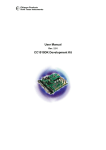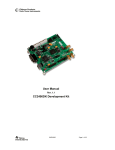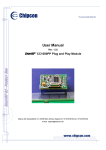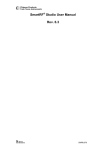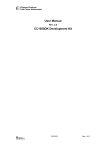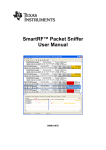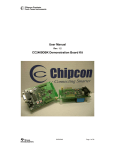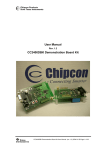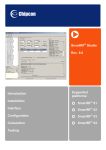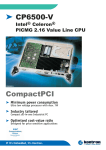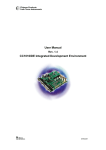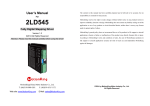Download CC1010DK User Manual
Transcript
User Manual Rev. 2.01 CC1010DK Development Kit SWRU055 Table of contents INTRODUCTION ....................................................................................................................... 3 EVALUATION MODULE........................................................................................................... 4 CIRCUIT DESCRIPTION .............................................................................................................. 4 PCB LAYOUT ........................................................................................................................... 5 SCHEMATIC, CC1010EM-433 .................................................................................................. 7 BILL OF MATERIALS, CC1010EM-433 ....................................................................................... 8 SCHEMATIC, CC1010EM-868 ................................................................................................ 11 BILL OF MATERIALS, CC1010EM-868 ..................................................................................... 12 EVALUATION BOARD ........................................................................................................... 15 POWER SUPPLY SECTION ........................................................................................................ 15 RS-232 INTERFACES .............................................................................................................. 16 PARALLEL INTERFACE ............................................................................................................. 16 JUMPERS ............................................................................................................................... 16 PERIPHERALS......................................................................................................................... 18 CONNECTORS ........................................................................................................................ 19 PCB LAYOUT ......................................................................................................................... 23 SCHEMATICS, CC1010EB...................................................................................................... 25 BILL OF MATERIALS, CC1010EB ............................................................................................ 30 USING THE DEVELOPMENT KIT.......................................................................................... 34 CC1010 RF EVALUATION USING SMARTRF® STUDIO............................................................... 34 SOFTWARE DEVELOPMENT USING THE IDE .............................................................................. 37 SERIAL CABLE PINOUT ....................................................................................................... 38 TROUBLESHOOTING ............................................................................................................ 39 IT DOESN’T WORK ................................................................................................................... 39 I CANNOT PROGRAM THE CC1010........................................................................................... 39 I CANNOT COMMUNICATE WITH THE CC1010 USING THE SERIAL PORT ....................................... 39 THE CC1010 DOESN’T OPERATE BELOW 3.1V (2.9±0.2V) ....................................................... 39 THE CC1010 CONSUMES MORE THAN THE RATED CURRENT IN POWER-DOWN MODE .................. 39 THE DEBUGGER CANNOT COMMUNICATE WITH THE CC1010 ..................................................... 39 DISCLAIMER .......................................................................................................................... 40 SWRU055 Page 2 of 40 Introduction The CC1010 single chip RF transceiver and microcontroller provides a single-chip solution for a wide range of applications. The CC1010DK development kit is designed to make it easy for the user to evaluate the RF performance of the CC1010 and develop application software very quickly. The Development Kit includes an Evaluation Board and two Evaluation Modules. The Evaluation Modules contain the CC1010 chip and associated support circuits. The Modules can operate in a stand-alone fashion. The Evaluation Board serves as a motherboard for the Evaluation Modules. The Evaluation Board provides two serial ports, a parallel interface, buttons, LEDs, voltage regulator, configuration jumpers and connectors to make it easy to interface the CC1010 with the IDE, SmartRF® Studio and various test equipment. This User Manual describes how to use the hardware part of the Development Kit. The Chipcon-supplied software is documented in the IDE user manual, and the Keil µVision 2 C compiler is documented in the Keil documentation. SmartRF® Studio is documented in its own user manual. The CC1010DK Development Kit includes what you need to evaluate the RF performance of the CC1010, develop your own software for the CC1010 and can also be used to build a prototype of your application. An evaluation version of the Keil µVision 2 C compiler is included on the CD; this has a 2KB code size limitation. Your SmartRF® CC1010DK Development Kit should contain the following items: Kit contents Item Number of articles Evaluation Board (CC1010EB) 1 Evaluation Module (CC1010EM) 2 Quick Start instructions 1 Chipcon CD 1 Antenna, 50Ω quarter-wave monopole, SMA male connector 2 SMA to BNC adapters 3 Parallel port cable 1 Serial null-modem cable 1 CC1010 sample kit 1 SWRU055 Page 3 of 40 Evaluation Module The Evaluation Module contains the CC1010 chip, the needed external circuitry for operation, pull-up resistors for all general I/O pins, test points and a temperature sensor. Not all components are needed in an actual application. Please see the datasheet for a typical application circuit. The Evaluation Module is produced in two versions; the difference between them is the frequency band of operation. One version is optimized for use at 433 MHz, the other for use at 868 MHz and at 915 MHz. This covers the most used frequency bands, the 433 MHz band in Europe and the US, the 868 MHz band in Europe, and the 902-928 MHz band in the US. See application note AN001 for more information about applicable regulations. The operating frequency band is marked on the PCB. Circuit description The CC1010 RF section includes all the necessary components for correct operation. An LC filter is inserted between the CC1010 RF input/output and the antenna connector to reduce harmonics. This LC filter is of the 3dB-equal ripple (Chebychev) low-pass type. The design equations are: 1 ⎛ ⎞ ⎟, ⎝ 1 − 0.1333 ⎠ ω C ≈ ω RF ⋅ ⎜ L= 35.6 ωC , C= 0.067 ωC , where ωC is the cut-off frequency and ωRF is the transmitted RF frequency. The filter is designed for 50Ω termination impedances. If you wish to evaluate the CC1010 without an LC filter, please remove capacitors C8 and C) and replace the L1 inductor with a 0Ω resistor. The VCO inductor (L101) is located on the bottom side of the PCB, all other RF components are on the top side. The CC1010 is connected to both a 14.7456 MHz high-frequency crystal and a 32.768 kHz low-frequency crystal. The high-frequency crystal is furnished with a trimmer capacitor to adjust the initial frequency tolerance. An external signal can be applied at test pin TP1, remember to remove the crystal before applying an external clock signal. The external clock should have an amplitude of 1 – 3 V peak-to-peak. Power can easily be applied to the board by using the TP3 and TP4 test points, or connecting the power source to the adjoining bare copper areas. The TP2, TP5 and TP6 test points provide easy access to the P0.0, P0.1 and P0.2 I/O pins, respectively. All general-purpose I/O pins are furnished with pull-up resistors, ensuring that the pins do not float if they are configured as inputs. An LM-61 temperature sensor from National Semiconductor is also included on the board, and is connected to the AD1 pin. If this pin is to be used for other purposes, the temperature sensor should be removed. The Evaluation Module can be plugged into the Evaluation Board. 2 2x20 pin pin-row connectors with 0.050-inch pitch are used for this purpose. Shorting the T1 and T2 pads together for a short period will reset the CC1010. SWRU055 Page 4 of 40 High-frequency crystal Trimmer capacitor 32.768 kHz crystal Power connections Antenna connector CC1010 Temperature sensor Figure 1: CC1010EM Evaluation Module PCB layout The figure above shows the 1.0 revision of the PCB. Later revisions are similar, but have the following additional features: • 0-ohm series resistor between the temperature sensor and the AD1 bit of CC1010. Instead of desoldering the temperature sensor if you wish to use AD1 for other purposes, you can desolder the 0-ohm resistor. • 0-ohm series resistor between temperature sensor and VDD. Instead of desoldering the temperature sensor when measuring the power-down current of the CC1010, you can desolder the 0-ohm resistor. RF circuits operating at high frequencies are sensitive to the physical layout of the PCB. Chipcon has carefully optimized the layout of the CC1010EM evaluation module, and we recommend that you copy it when making your own PCB design. The PCB is of a 4-layer type in order to provide a good ground plane as well as adequate routing space. The laminate used is standard FR-4 board material. The PCB is 1.6mm thick, with layer 1 on the top side, layers 2 and 3 are internal layers and layer 4 is on the bottom side. Layers 1 and 4 are used for routing, while layer 2 is a ground plane and layer 3 is used for power routing. All areas not utilized for routing are filled with copper connected to ground to provide RF shielding. The ground planes on all layers are stitched together with closely spaced vias. To minimize LO leakage and allow space for decoupling capacitors close to the CC1010, the VCO inductor (L101) is placed on the bottom side of the PCB. EMI beads for power-supply filtering are also placed on the bottom side, together with the pull-up resistors. All other components are placed on the top side of the PCB. SWRU055 Page 5 of 40 Figure 2: CC1010EM PCB layout, layer 1 (left) and layer 3 (right) Figure 3: CC1010EM PCB layout, layer 4 (left) and layer 2 (right, negative) Figure 4: CC1010EM component placement, top side (left) and bottom side (right) SWRU055 Page 6 of 40 Schematic, CC1010EM-433 Please note that the TEST_N pin should be connected to VDD in your design. See page 40 for more information. SWRU055 Page 7 of 40 Bill of materials, CC1010EM-433 Bill of materials, CC1010EM-433 Reference Description Value Part C1 Capacitor, tantal 3.3uF C_3U3_TAN_B C4 Capacitor 0603 1nF, 5% C_1N0_0603_X7R_J_50 C8 Capacitor 0603 12pF, 5% C_12P_0603_NP0_J_50 C9 Capacitor 0603 12pF, 5% C_12P_0603_NP0_J_50 C12 Capacitor 0603 6.8pF, ±0.25pF C_6P8_0603_NP0_C_50 C13 Capacitor 0603 6.8pF, ±0.25pF C_6P8_0603_NP0_C_50 C14 Capacitor 0603 15pF, 5% C_15P_0603_NP0_K_50 C15 Capacitor 0603 15pF, 5% C_15P_0603_NP0_K_50 C19 Capacitor 0603 33nF, 10% C_33N_0603_X7R_K_25 C20 Capacitor 0603 220pF, 5% C_220P_0603_NP0_G_50 C21 Capacitor 0603 33nF, 10% C_33N_0603_X7R_K_25 C22 Capacitor 0603 150pF, 5% C_150P_0603_NP0_G_50 C23 Capacitor 0603 general C24 Capacitor 0603 150pF, 5% C_150P_0603_NP0_J_50 C25 Capacitor 0603 33nF, 10% C_33N_0603_X7R_K_25 C26 Capacitor 0603 150pF, 5% C_150P_0603_NP0_J_50 C27 Capacitor 0603 33nF, 10% C_33N_0603_X7R_K_25 C31 Capacitor 0603 10pF, 5% C_10P_0603_NP0_J_50 C32 Capacitor 0603 1nF, 5% C_1N0_0603_X7R_J_50 C34 Capacitor 0603 33nF, 10% C_33N_0603_X7R_K_25 C35 Capacitor 0603 1nF, 10% C_1N0_0603_X7R_K_50 C41 Capacitor 0603 6.8pF, ±0.25pF C_6P8_0603_NP0_C_50 C42 Capacitor 0603 8.2pF, ±0.25pF C_8P2_0603_NP0_C_50 C47 Capacitor 0603 33nF, 10% C_33N_0603_X7R_K_25 CT1 Trimmer Capacitor 3-10pF C_3-10P_TRIM_NP0 L1 Inductor 0805 15nH, 5% L_15N_0805_J L2 Resistor 0603 0Ω R_0_0603 L3 Resistor 0603 0Ω R_0_0603 L7 Resistor 0603 0Ω R_0_0603 L8 Resistor 0603 0Ω R_0_0603 L9 Resistor 0603 0Ω R_0_0603 L10 Resistor 0603 0Ω R_0_0603 Do not mount SWRU055 Page 8 of 40 Bill of materials, CC1010EM-433 Reference Description Value Part L20 Resistor 0603 0Ω R_0_0603 L21 Resistor 0603 0Ω R_0_0603 L22 Resistor 0603 0Ω R_0_0603 L32 Inductor 0805 68nH, 5% L_68N_0805_J L41 Inductor, 0805 6.2nH, 5% L_6N2_0805_J L101 Inductor, 0603 (KOA) 27nH, 5% L_27N_0603_KL73, KOA KL731JTE27NJ P1 SMD pin-row socket, .050 spacing SMD_SOCKET_2X20, Samtec SFM120-02-S-D-A-K-TR P2 SMD pin-row socket, .050 spacing SMD_SOCKET_2X20, Samtec SFM120-02-S-D-A-K-TR P3 Surface-mount SMA, straight SMA_SMD R1 Resistor 0603 47kΩ, 2% R_47K_0603_G R3 Resistor 0603 47kΩ, 2% R_47K_0603_G R4 Resistor 0603 47kΩ, 2% R_47K_0603_G R5 Resistor 0603 47kΩ, 2% R_47K_0603_G R6 Resistor 0603 47kΩ, 2% R_47K_0603_G R7 Resistor 0603 47kΩ, 2% R_47K_0603_G R8 Resistor 0603, general R9 Resistor 0603 47kΩ, 2% R_47K_0603_G R10 Resistor 0603 27kΩ, 2% R_27K_0603_G R11 Resistor 0603 47kΩ, 2% R_47K_0603_G R12 Resistor 0603 47kΩ, 2% R_47K_0603_G R13 Resistor 0603 47kΩ, 2% R_47K_0603_G R14 Resistor 0603 47kΩ, 2% R_47K_0603_G R15 Resistor 0603 47kΩ, 2% R_47K_0603_G R16 Resistor 0603 47kΩ, 2% R_47K_0603_G R17 Resistor 0603 47kΩ, 2% R_47K_0603_G R18 Resistor 0603 47kΩ, 2% R_47K_0603_G R19 Resistor 0603 47kΩ, 2% R_47K_0603_G R20 Resistor 0603 47kΩ, 2% R_47K_0603_G R21 Resistor 0603 47kΩ, 2% R_47K_0603_G R22 Resistor 0603 47kΩ, 2% R_47K_0603_G R23 Resistor 0603 47kΩ, 2% R_47K_0603_G Do Not Mount SWRU055 Page 9 of 40 Bill of materials, CC1010EM-433 Reference Description Value Part R24 Resistor 0603 47kΩ, 2% R_47K_0603_G R25 Resistor 0603 47kΩ, 2% R_47K_0603_G R26 Resistor 0603 47kΩ, 2% R_47K_0603_G R27 Resistor 0603 47kΩ, 2% R_47K_0603_G R28 Resistor 0603 R29 Resistor 0603 47kΩ, 2% R_47K_0603_G R30 Resistor 0603 47kΩ, 2% R_47K_0603_G R31 Resistor 0603 47kΩ, 2% R_47K_0603_G R32 Resistor 0603 47kΩ, 2% R_47K_0603_G R33 Resistor 0603 47kΩ, 2% R_47K_0603_G R131 Resistor 0603 82kΩ, 1% R_82K_0603_F TP1 Testpoint TESTPIN TP2 Testpoint TESTPIN TP3 Testpoint TESTPIN TP4 Testpoint TESTPIN TP5 Testpoint TESTPIN TP6 Testpoint TESTPIN U1 Single-chip transceiver and microcontroller CC1010 U2 Temperature sensor, SOT23 LM61, National Semiconductor LM61CIM3 X1 Crystal, HC-49-SMD X 14.7456 MHz 10/10/10/16pF load X2 Watch crystal, plastic SMD package X 32.768 kHz 20/50/10/12pF load Do not mount SWRU055 Page 10 of 40 Schematic, CC1010EM-868 Please note that the TEST_N pin should be connected to VDD in your design. See page 40 for more information. SWRU055 Page 11 of 40 Bill of materials, CC1010EM-868 Bill of materials, CC1010EM-868 Reference Description Value Part C1 Capacitor, tantal 3.3uF C_3U3_TAN_B C4 Capacitor 0603 1nF, 5% C_1N0_0603_X7R_J_50 C8 Capacitor 0603 10pF, 5% C_10P_0603_NP0_J_50 C9 Capacitor 0603 8.2pF, ±0.25pF C_8P2_0603_NP0_C_50 C12 Capacitor 0603 6.8pF, ±0.25pF C_6P8_0603_NP0_C_50 C13 Capacitor 0603 6.8pF, ±0.25pF C_6P8_0603_NP0_C_50 C14 Capacitor 0603 15pF, 5% C_15P_0603_NP0_J_50 C15 Capacitor 0603 15pF, 5% C_15P_0603_NP0_J_50 C19 Capacitor 0603 33nF, 10% C_33N_0603_X7R_K_25 C20 Capacitor 0603 220pF, 5% C_220P_0603_NP0_G_50 C21 Capacitor 0603 33nF, 10% C_33N_0603_X7R_K_25 C22 Capacitor 0603 22pF, 5% C_22P_0603_NP0_J_50 C23 Capacitor 0603 150pF, 5% C_150P_0603_NP0_J_50 C24 Capacitor 0603 150pF, 5% C_150P_0603_NP0_J_50 C25 Capacitor 0603 33nF, 10% C_33N_0603_X7R_K_25 C26 Capacitor 0603 12pF, 5% C_12P_0603_NP0_J_50 C27 Capacitor 0603 33nF, 10% C_33N_0603_X7R_K_25 C31 Capacitor 0603 8.2pF, ±0.25pF C_8P2_0603_NP0_C_50 C32 Capacitor 0603 1nF, 5% C_1N0_0603_X7R_J_50 C34 Capacitor 0603 33nF, 10% C_33N_0603_X7R_K_25 C35 Capacitor 0603 1nF, 10% C_1N0_0603_X7R_K_50 C41 Capacitor 0603, general C42 Capacitor 0603 10pF, 5% C_10P_0603_NP0_J_50 C47 Capacitor 0603 33nF, 10% C_33N_0603_X7R_K_25 CT1 Trimmer Capacitor 3-10pF C_3-10P_TRIM_NP0 L1 Inductor 0805 3.3nH, ± 0.5nH L_3N3_0805_D L2 EMI Filter Bead BLM18HG102SN1D, Murata L3 EMI Filter Bead BLM18HG102SN1D, Murata L7 EMI Filter Bead BLM18HG102SN1D, Murata L8 Resistor 0603 0Ω R_0_0603 L9 Resistor 0603 0Ω R_0_0603 L10 Resistor 0603 0Ω R_0_0603 L20 Resistor 0603 0Ω R_0_0603 Do Not Mount SWRU055 Page 12 of 40 Bill of materials, CC1010EM-868 Reference Description Value Part L21 Resistor 0603 0Ω R_0_0603 L22 Resistor 0603 0Ω R_0_0603 L32 Inductor 0805 12nH, 5% L_12N_0805_J L41 Inductor, 0805 2.5nH, 5% L_2N5_0805_J L101 Inductor, 0603 (KOA) 3.3nH, 5% L_3N3_0603_KL73, KOA KL731JTE3N3J P1 SMD pin-row socket, .050 spacing SMD_SOCKET_2X20, Samtec SFM120-02-S-D-A-K-TR P2 SMD pin-row socket, .050 spacing SMD_SOCKET_2X20, Samtec SFM120-02-S-D-A-K-TR P3 Surface-mount SMA, straight SMA_SMD R1 Resistor 0603 47kΩ, 2% R_47K_0603_G R3 Resistor 0603 47kΩ, 2% R_47K_0603_G R4 Resistor 0603 47kΩ, 2% R_47K_0603_G R5 Resistor 0603 47kΩ, 2% R_47K_0603_G R6 Resistor 0603 47kΩ, 2% R_47K_0603_G R7 Resistor 0603 47kΩ, 2% R_47K_0603_G R8 Resistor 0603,general R9 Resistor 0603 47kΩ, 2% R_47K_0603_G R10 Resistor 0603 27kΩ, 2% R_27K_0603_G R11 Resistor 0603 47kΩ, 2% R_47K_0603_G R12 Resistor 0603 47kΩ, 2% R_47K_0603_G R13 Resistor 0603 47kΩ, 2% R_47K_0603_G R14 Resistor 0603 47kΩ, 2% R_47K_0603_G R15 Resistor 0603 47kΩ, 2% R_47K_0603_G R16 Resistor 0603 47kΩ, 2% R_47K_0603_G R17 Resistor 0603 47kΩ, 2% R_47K_0603_G R18 Resistor 0603 47kΩ, 2% R_47K_0603_G R19 Resistor 0603 47kΩ, 2% R_47K_0603_G R20 Resistor 0603 47kΩ, 2% R_47K_0603_G R21 Resistor 0603 47kΩ, 2% R_47K_0603_G R22 Resistor 0603 47kΩ, 2% R_47K_0603_G R23 Resistor 0603 47kΩ, 2% R_47K_0603_G R24 Resistor 0603 47kΩ, 2% R_47K_0603_G Do Not Mount SWRU055 Page 13 of 40 Bill of materials, CC1010EM-868 Reference Description Value Part R25 Resistor 0603 47kΩ, 2% R_47K_0603_G R26 Resistor 0603 47kΩ, 2% R_47K_0603_G R27 Resistor 0603 47kΩ, 2% R_47K_0603_G R28 Resistor 0603 R29 Resistor 0603 47kΩ, 2% R_47K_0603_G R30 Resistor 0603 47kΩ, 2% R_47K_0603_G R31 Resistor 0603 47kΩ, 2% R_47K_0603_G R32 Resistor 0603 47kΩ, 2% R_47K_0603_G R33 Resistor 0603 47kΩ, 2% R_47K_0603_G R131 Resistor 0603 82kΩ, 1% R_82K_0603_F TP1 Testpoint TESTPIN TP2 Testpoint TESTPIN TP3 Testpoint TESTPIN TP4 Testpoint TESTPIN TP5 Testpoint TESTPIN TP6 Testpoint TESTPIN U1 Single-chip transceiver and microcontroller CC1010 U2 Temperature sensor, SOT23 LM61, National Semiconductor LM61CIM3 X1 Crystal, HC-49-SMD X 14.7456 MHz 10/10/10/16pF load X2 Watch crystal, plastic SMD package X 32.768 kHz 20/50/10/12pF load Do not mount SWRU055 Page 14 of 40 Evaluation Board The Evaluation Board is used as a motherboard for the Evaluation Modules, providing external circuitry for easy prototyping and connectors for easy connection to external equipment. The figure below shows the first revision of the Evaluation Board; in revisions 3.0 and later the AD1 and AD2 connectors were removed, and a separate connector for analog data out was added. Power terminal block DC jack power input SPI I/O connector SMA connectors Potmeter Buttons Power selection switch LEDs Jumpers Digital I/O B connector Serial port 0 Analog I/O connector Serial port 1 Parallel port Digital I/O A connector Figure 5: CC1010EB Evaluation Board (with CC1010EM plugged in) Power supply section You can choose between applying a 4-10V unregulated supply voltage or a 3.3V regulated supply voltage by using the SPDT switch. If an unregulated supply voltage is applied, a onboard regulator supplies 3.3V to the board. A diode prevents damage if wrong polarity is applied to the non-regulated input. There are two power connectors; a 3.5mm DC jack-type connector allows you to connect an unregulated battery eliminator easily (the positive supply is on the center pin), and a 5-pin terminal block for connecting either an unregulated or regulated power supply. An amperemeter can also be connected in order to measure the DC current drawn by the CC1010. Note that these terminals measure all the current going to the CC1010 Evaluation Module, therefore current drawn by the temperature sensor and pull-up resistors will also be measured. If you are going to measure the power-down current of the CC1010 accurately, you should remove the temperature sensor on the Evaluation Module (it draws over 100uA), and set all the CC1010 I/O pins to be inputs or outputs set to the high state. If you are not SWRU055 Page 15 of 40 going to measure the current, a short-circuit jumper must be connected between these two terminals, otherwise the Evaluation Module will not be supplied with power. 4-10V 0V 3V A Iout Figure 6: Power terminal block with amperemeter attached On the PCB, all pins connected to regulated power are marked with VCC. On the schematics, this net is called +3.3V. Power going to the Evaluation Module connector is named +3.3V_RF. RS-232 interfaces The Evaluation Board provides two serial ports, Serial 0 and Serial 1. The serial ports are configured as DTE (Data Terminal Equipment, in other words identical to a PC). Therefore, a null-modem cable with data lines crossed must be used to connect these ports to a PC. A level-conversion circuit is provided to convert the CMOS levels used by the CC1010 into RS232 compliant bipolar +5V/-5V signals. Note that this circuit contains a charge-pump power supply that is quite noisy. When doing performance evaluation of the CC1010 RF section, we recommend that you turn this circuit off by inserting the SER OFF strap. Serial 0 implements the RTS/CTS handshaking pair, so that hardware handshaking may be used on this port. These signals are available at pins P1.5 and P1.6. Serial 1 is primarily used by the Keil debugger to communicate with the CC1010 when the debugger is running. Serial 1 does not implement hardware handshaking. A way to reset the CC1010 via this port is provided; removing the SER RST jumper will disable this function. Parallel interface The Evaluation Board also provides a parallel interface for connection to a parallel port on a PC. This interface is used to communicate with SmartRF® Studio and the CC1010 Flash Programmer program. The parallel interface can be disconnected from the CC1010 I/O pins by removing the PAR EN jumper. Removing the PAR PROG jumper will disable parallel programming of the CC1010. Jumpers The jumpers are used to configure the Evaluation Board. The factory default settings are shown below, please return to these settings if you are experiencing any problems. SWRU055 Page 16 of 40 Figure 7 Default jumper settings Jumpers Name Default setting Description AD1 TEMP Not present If present, connects the temperature sensor footprint on the Evaluation Board to the AD1 pin of the CC1010. (Note: This jumper does not control the temperature sensor located on the Evaluation Module) In PCB revision 3.0 and later, this strap does not exist. Neither does the footprint on the EB for the temperature sensor. AD0 POT Present If present, connects the RT1 potmeter to the AD0 pin of the CC1010. PAR PROG Present If present, enables programming of the CC1010 Flash memory via the parallel interface. POR ON Present If present, enables the internal power-on reset module of the CC1010. When enabled, the supply voltage must be over 2.9V ±0.2V for the CC1010 to exit the reset condition. TEST OFF Present This jumper should always be present. SER RST Present If present, enables resetting the CC1010 via the SERIAL 1 serial port. PAR RST Present If present, enables resetting the CC1010 via the parallel interface. SER OFF Not present If present, disables the RS-232 interface circuitry. Because this circuitry generates noise, we recommend disabling it when sensitive RF measurements are performed. If the circuitry is disabled, the serial ports cannot be used. DIO ANA Present When present, enables adjustment of the DIO peak-to-peak signal level using the DIO ATT potmeter when performing BER testing using SmartRF® Studio. In PCB revision 3.0 and later, this strap does not exist as analog data out has its own separate connector. PAR EN Present When present, enables the parallel interface. If this is disabled, communication with SmartRF® Studio or the CC1010 Flash programmer is impossible. SWRU055 Page 17 of 40 Peripherals The Evaluation Board includes a number of peripherals to allow quick testing and prototyping. A potmeter (RT1, marked “POT”) provides an analogue voltage that can be applied to the AD0 pin of the CC1010. Four momentary pushbuttons are provided. They are connected to pins P1.7, P3.2, P3.3 and P2.4. The buttons connect the I/O pins to ground when pushed. Four LEDs are provided. They are connected to pins P1.2, P1.3, P1.4 and P2.5. LED 1 is red, LED 2 is yellow, LED 3 is green and LED 4 is blue. The LEDs are connected to VCC via resistors, and the cathodes are connected to the CC1010 I/O pins via a buffer. Driving the CC1010 pin low will therefore light the LED. The two PWM outputs of the CC1010 (PWM2 at pin P3.4 and PWM3 at pin P3.5) are provided with buffers and RC-filters with a 3-kHz cutoff frequency. The outputs from the filters are buffered by rail-to-rail op-amps, and are available at the ANALOG pin-row connector (P15). A footprint for a LM61 temperature sensor from National Semiconductor is provided on the PCB. This component is not mounted at the factory; rather there is an identical sensor on the Evaluation Module. A reset button is provided. When pushed, it will reset the CC1010 by pulling its RESET line low. Peripheral summary Peripheral CC1010 pin Description POT (RT1) AD0 10kΩ Potmeter. Can apply a voltage between VCC and 0V. Can be disconnected from AD0 by removing the AD0 POT jumper. Button 1 P1.7 Momentary pushbutton. When activated, pulls I/O line low. Button 2 P3.2 Momentary pushbutton. When activated, pulls I/O line low. Button 3 P3.3 Momentary pushbutton. When activated, pulls I/O line low. Button 4 P2.4 Momentary pushbutton. When activated, pulls I/O line low. LED 1 P1.2 Red LED. Buffered, lights up when I/O line is pulled low. LED 2 P1.3 Yellow LED. Buffered, lights up when I/O line is pulled low. LED 3 P1.4 Green LED. Buffered, lights up when I/O line is pulled low. LED 4 P2.5 Blue LED. Buffered, lights up when I/O line is pulled low. PWM 2 buffer and filter P3.4 PWM output is buffered by CMOS buffer, then low-pass filtered (RC filter with 3 kHz cut-off frequency) and buffered by a rail-to-rail op-amp. Output available at ANALOG connector. PWM 3 buffer and filter P3.5 PWM output is buffered by CMOS buffer, then low-pass filtered (RC filter with 3 kHz cut-off frequency) and buffered by a rail-to-rail op-amp. Output available at ANALOG connector. Temperature sensor AD1 Footprint for LM61CIM3 temperature sensor from National Semiconductor. Not mounted. Can be disconnected from AD1 by removing the AD0 POT jumper. This footprint is not present on revision 3.0 or later of the PCB. Note that an identical temperature sensor is mounted on the Evaluation Module. SWRU055 Page 18 of 40 Connectors The Evaluation Board is furnished with many connectors for easy access to signals. The I/O A (P14) and I/O B (P16) 2x10 pin pin-row connectors bring out all the general digital I/O pins of the CC1010. The pin-out is compatible with logic analyzer probes from Agilent. Analog signals are brought out on the 2x5 pin ANALOG (P15) connector. All A/D inputs to the CC1010 are available here, as well as buffered and filtered PWM outputs. The SPI (P5) connector brings out all signals related to CC1010 Flash programming and CC1010 SPI Master functionality. The Evaluation Modules are plugged into sockets P1 and P2. These sockets are keyed, and it is not possible to orient the module incorrectly. Make sure you have turned off all power to the Evaluation Board before inserting or removing any Modules. Several important signals have been brought out on SMA connectors for easy access. AD2/RSSI/IF brings out the AD2/RSSI/IF pin on the CC1010. The AD1/REF connector is connected to the AD1 pin on the CD1010. The DIO and DCLK pins are connected to the P0.1 and P0.2 pins on the CC1010. When using SmartRF® Studio, the CC1010 can “emulate” the CC1000 for RF measurements. The recovered clock signal will then be available on the DIO connector, and DIO will present received data in RX mode, and the user can apply data to DIO in TX mode. The DIO ATT potmeter can be used to adjust the amplitude of the DIO signal in TX mode when BER measurements are done. Please see the section on BER testing in this manual for more information. Some modifications have been made on PCB revisions 3.0 and later. The AD1/REF and AD2/RSSI/IF SMA connectors have been removed (the signals are still available on the ANALOG pin-row connector), and a separate analog data out connector has been added. The identity of each pin is shown in the PCB silkscreen next to each pin. The tables below provide further information. If you make your own custom CC1010 PCB, we recommend including a connector similar to the SPI connector on the CC1010EB. You can then connect the two connectors together with a flat cable and use the CC1010EB to program flash and run the debugger. If you connect the VCC pins together, make sure that you’ve thought out the power supply issues. The regulator on the CC1010EB is not dimensioned for delivering large currents. The two boards should run on a common power supply. SWRU055 Page 19 of 40 SPI Connector (P5) Pin Description 1 GND 2 GND 3 SCK 4 MOSI 5 MISO 6 PROG_N 7 RESET_N 8 RXD1 (P2.0) 9 VCC 10 TXD1 (P2.1) Digital I/O connector A (P14) Pin Description 1 No connection 2 No connection 3 P0.0 4 VCC 5 VCC 6 P3.5 7 P3.4 8 P3.3 9 P3.2 10 P3.1 11 P3.0 12 PROG_N 13 POR_E 14 RESET_N 15 TEST_N 16 P0.3 17 P0.2 18 P0.1 19 P0.0 20 GND SWRU055 Page 20 of 40 Digital I/O connector B (P16) Pin Description 1 No connection 2 No connection 3 VCC 4 P2.7 5 P2.6 6 P2.5 7 P2.4 8 P2.3 9 P2.2 10 P2.1 11 P2.0 12 P1.7 13 P1.6 14 P1.5 15 P1.4 16 P1.3 17 P1.2 18 P1.1 19 P1.0 20 GND Analog I/O connector (P15) Pin Description 1 GND 2 GND 3 AD0 4 AD1 5 AD2 6 Buffered output from RC filter for PWM2 7 Buffered output from RC filter for PWM3 8 GND 9 VCC 10 VCC SWRU055 Page 21 of 40 CC1010 I/O pin summary Pin Alternate function Connector Connected peripherals AD0 ANALOG pin 3 Potmeter (POT, RT1) AD1 ANALOG pin 4 Temperature sensor. SMA connector not present on PCB revision 3.0 and later AD2 RSSI, external IF ANALOG pin 5, SMA connector P0.0 SCK (Flash programming and SPI Master) P14 pin 3 and 19, SPI pin 3 P0.1 MOSI (Flash programming and SPI Master), DIO P14 pin 18, SPI pin 4, SMA P0.2 MISO (Flash programming and SPI Master), DCLK P14 pin 17, SPI pin 5, SMA DIO analog amplitude circuitry P0.3 P14 pin 16 P1.0 P16 pin 19 P1.1 P16 pin 18 P1.2 P16 pin 17 LED 1 (red) P1.3 P16 pin 16 LED 2 (yellow) P1.4 P16 pin 15 LED 3 (green) P1.5 P16 pin 14 RTS0 (Ready To Send on serial port 0) P1.6 P16 pin 13 CTS0 (Clear To Send on serial port 0) P1.7 P16 pin 12 Button 1 P2.0 UART 1 receive data P16 pin 11 RXD1 (Receive data on serial port 1) P2.1 UART 1 transmit data P16 pin 10 TXD1 (Transmit data on serial port 1) P2.2 P16 pin 9 DIO_SELECT (Toggles between analog and digital DIO operation) This signal is not used in PCB revisions 3.0 and later. P2.3 P16 pin 8 P2.4 P16 pin 7 Button 4 P2.5 P16 pin 6 LED 4 (blue) P2.6 LOCK P2.7 P16 pin 5, TP6 P16 pin 4 P3.0 UART 0 receive data P14 pin 11 RXD0 (Receive data on serial port 0) P3.1 UART 1 transmit data P14 pin 10 TXD0 (Transmit data on serial port 0) P3.2 INT0 external interrupt P14 pin 9 Button 2 SWRU055 Page 22 of 40 CC1010 I/O pin summary Pin Alternate function P3.3 INT1 external interrupt P3.4 PWM2, T0 external input P3.5 PWM3, T1 external input Connector Connected peripherals PCB layout The Evaluation Board is a 4-layer, 1.6mm thick FR-4 PCB. Four layers are used because of the routing requirements. Layers 1 and 4 are used for signal routing, layer 2 is a ground plane and layer 3 is a power plane. All components are mounted on the top side of the PCB. Figure 8: CC1010EB PCB layout, layer 1 (left) and layer 4 (right) SWRU055 Page 23 of 40 Figure 9: CC1010EB component placement SWRU055 Page 24 of 40 Schematics, CC1010EB SWRU055 Page 25 of 40 SWRU055 Page 26 of 40 SWRU055 Page 27 of 40 SWRU055 Page 28 of 40 SWRU055 Page 29 of 40 SWRU055 Page 30 of 40 Bill of Materials, CC1010EB Bill of materials, CC1010EB Evaluation Board Reference Description Value Part C1 Capacitor, tantal 3.3uF C_3U3_TAN_B C2 Capacitor 0603 33nF, 10% C_33N_0603_X7R_K_25 C3 Capacitor, tantal 3.3uF C_3U3_TAN_B C5 Capacitor 0603 100nF, 10% C_100N_0603_X7R_K_50 C6 Capacitor, tantal 3.3uF C_3U3_TAN_B C10 Capacitor 0603 33nF, 10% C_33N_0603_X7R_K_25 C11 Capacitor 0603 100nF, 10% C_100N_0603_X7R_K_50 C16 Capacitor 0603 C27 Capacitor 0603 100nF, 10% C_100N_0603_X7R_K_50 C28 Capacitor 0603 100nF, 10% C_100N_0603_X7R_K_50 C29 Capacitor 0603 100pF, 5% C_100P_0603_NP0_J_50 C33 Capacitor 0603 33nF, 10% C_33N_0603_X7R_K_25 C36 Capacitor 0603 33nF, 10% C_33N_0603_X7R_K_25 C37 Capacitor 0603 2.2nF, 10% C_2N2_0603_X7R_K_50 C38 Capacitor 0603 2.2nF, 10% C_2N2_0603_X7R_K_50 C39 Capacitor 0603 33nF, 10% C_33N_0603_X7R_K_25 C40 Capacitor, tantal 3.3uF C_3U3_TAN_B C43 Capacitor 0603 33nF, 10% C_33N_0603_X7R_K_25 C44 Capacitor 0603 100pF, 5% C_100P_0603_NP0_J_50 C45 Capacitor, tantal 3.3uF C_3U3_TAN_B C46 Capacitor 0603 33nF, 10% C_33N_0603_X7R_K_25 C48 Capacitor, tantal 3.3uF C_3U3_TAN_B C51 Capacitor 0603 33nF, 10% C_33N_0603_X7R_K_25 C52 Capacitor 0603 33nF, 10% C_33N_0603_X7R_K_25 D1 Diode, Si BAT254 D2 LED, green, SMD LED_CL150GCD, Citizen D3 LED, red, SMD LED_CL150URCD, Citizen D4 LED, yellow, SMD LED_CL150YCD, Citizen D5 LED, blue, SMD LED_EL15-21UBC, Everlight H1 Circuit board support Distance 12.5mm H2 Circuit board support Distance 12.5mm H3 Circuit board support Distance 12.5mm H4 Circuit board support Distance 12.5mm L5 Inductor, 0805 DNM 120nH SWRU055 L_120N_0805_J Page 31 of 40 Bill of materials, CC1010EB Evaluation Board Reference Description Value Part L6 Inductor, 0805 120nH L_120N_0805_J P1 SMD pin-row header, .050 spacing TFM-120-02-S-D-K-TR-A, Samtec P2 SMD pin-row header, .050 spacing TFM-120-02-S-D-K-TR-A, Samtec P3 D-Sub, 9-pin DSUB_9 (male) P5 Pin-row, 2x5 PINROW_2X5 P7 D-Sub, 9pin DSUB_9 (male) P8 Pin-row, 2x5 STRAP_5 P9 Pin-row, 2x5 STRAP_5 P10 SMA connector SMA (Right angle) P11 SMA connector SMA (Right angle) P12 D-Sub, 25-pin DSUB_25 P13 SMA connector SMA (Right angle) P14 Pin-row, 2x10 PINROW_2X10 P15 Pin-row, 2x5 PINROW_2X5 P16 Pin-row, 2x10 PINROW_2X10 P17 SMA connector SMA (Right angle) P20 5-pin terminal, screw SCREW_TERM_5 P21 DC jack, 2.5mm center pin DC_JACK_2.5 R1 Resistor 0603 47kΩ R_47K_0603_G R2 Resistor 0603 47kΩ R_47K_0603_G R3 Resistor 0603 47kΩ R_47K_0603_G R4 Resistor 0603 47kΩ R_47K_0603_G R11 Resistor 0603 47kΩ R_47K_0603_G R12 Resistor 0603 47kΩ R_47K_0603_G R13 Resistor 0805 270Ω R_270_0805_J R14 Resistor 0805 270Ω R_270_0805_J R15 Resistor 0805 270Ω R_270_0805_J R16 Resistor 0805 270Ω R_270_0805_J R17 Resistor 0603 150kΩ R_150K_0603_J R18 Resistor 0603 47kΩ R_47K_0603_G R19 Resistor 0603 150kΩ R_150K_0603_J R20 Resistor 0805 270Ω R_270_0805_J SWRU055 Page 32 of 40 Bill of materials, CC1010EB Evaluation Board Reference Description Value Part R21 Resistor 0805 270Ω R_270_0805_J R22 Resistor 0805 270Ω R_270_0805_J R23 Resistor 0805 330Ω R_330_0805_J R56 Resistor 0603 47kΩ R_47K_0603_G R57 Resistor 0603 47kΩ R_47K_0603_G RT1 Trimming potmeter, 10K, knob 10kΩ 72PTR10K, BI Technologies RT2 Trimming potmeter, 10K, knob 10kΩ 72PTR10K, BI Technologies S1 SPDT switch SWITCH_SPDT S2 Push button, SMD SKHUAF, Alps S3 Push button, SMD SKHUAF, Alps S4 Push button, SMD SKHUAF, Alps S5 Push button, SMD SKHUAF, Alps S6 Push button, SMD SKHUAF, Alps TP6 Test point TESTPIN U2 Temperature sensor, SOT23 Do Not Mount U3 RS-232 Transceiver, 3-5V MAX3243EEWI, Maxim U4 3.3V low drop-out regulator LP2981AIM5-3.3, National Semiconductor U5 Quad NAND gate w/ open drain output 74HC03 U6 Hex non-inverting buffer, tri-state output 74HC365 U7 Octal dual-supply buffer, tri-state output 74LVC4245A U8 Octal dual-supply buffer, tri-state output 74LVC4245A U9 Quad bilateral switch 74HC4066 U10 Quad rail-to-rail opamp AD8544AR, Analog Devices SWRU055 Page 33 of 40 Using the Development Kit The Development Kit is useful for providing hands-on experience with the CC1010 for both software and hardware developers. The plug-in Evaluation Module provides flexibility; it can operate both in a stand-alone fashion and together with the Evaluation Board. Using the Evaluation Board, it is easy to interface the CC1010 with both test equipment and additional application circuitry without having to make a PCB from scratch. Below we will highlight the most useful setups. CC1010 RF Evaluation using SmartRF® Studio Spectrum analyzer / RF Signal generator CC1010 EM PC running SmartRF Studio CC1010 Evaulation Board Oscilloscope / Function generator Figure 10: RF Evaluation using SmartRF® Studio Using the setup shown below, the RF performance of the CC1010 can be evaluated. Use a parallel cable to connect the parallel interface of the CC1010EB to the parallel port of a PC running SmartRF® Studio. You can then use SmartRF® Studio to control all the RF parameters of the CC1010. To test the CC1010 in receive mode, apply an FSK signal from an RF signal generator to the antenna input of the CC1010EM. You can then observe the DIO and DCLK signals using an oscilloscope. To test the CC1010 in transmit mode, apply a 0-3V square wave on the DIO connector. For best results, this signal should be synchronized with the DCLK signal. The transmitted RF signal can be studied on a spectrum analyzer or sent to a receiver. Please note that we recommend that the SER OFF jumper be present when precise RF measurements are done in order to prevent noise from the charge pump power supply of the RS-232 level converter from disturbing your measurements. Important: The use of radio transceivers is regulated by international and national rules. Before transmitting an RF signal on an antenna, please contact your local telecommunication authorities to make sure that you are licensed to operate the transceiver. SWRU055 Page 34 of 40 RF signal generator CC1010 EM PC running SmartRF Studio CC1010 Evaulation Board Figure 11: BER testing using SmartRF® Studio SmartRF® Studio also includes built-in support for BER (bit-error rate) testing. Such test must be performed to determine sensitivity, blocking and other important parameters. To perform a BER test, the Evaluation Board should be connected with a parallel cable to a PC running SmartRF® Studio, as in the previous setup. The RF output of an RF signal generator should be connected to the antenna connector of the CC1010EM Evaluation module. The DIO connector on the Evaluation Board should be connected to the modulation input of the signal generator. RF signal generators usually require a modulation signal of specific amplitude. The amplitude of the DIO signal can be adjusted by turning the DIO ATT potmeter. Please note that the signal is AC-coupled, and that any signal below –0.7V will be clipped by the output circuitry. Please use an oscilloscope to observe the DIO signal and make sure it is compatible with the requirements of your RF signal generator before you apply the signal to expensive lab equipment! In PCB revisions 3.0 and later, there is a dedicated analog data out connector. This output does not clip signals below –0.7V. In this first revision, the BER testing does not work reliably with data rates above 4.8kbaud. The result will be continuously displayed by SmartRF® Studio. Make sure that you have put the CC1010 into RX mode. SWRU055 Page 35 of 40 Spectrum analyzer CC1010 EM PC running SmartRF Studio CC1010 Evaulation Board Figure 12: Modulation testing using SmartRF® Studio The CC1010 RF performance in transmit mode can also be evaluated without using any externally applied modulation, as SmartRF® Studio implements an internal function generator as well. Just connect the antenna connector of the CC1010EM to a spectrum analyzer, put the CC1010 into TX mode in SmartRF® Studio, and enable the BER estimator. You can choose between square wave and pseudo-random signals. Important: The use of radio transceivers is regulated by international and national rules. Before transmitting an RF signal on an antenna, please contact your local telecommunication authorities to make sure that you are licensed to operate the transceiver. SWRU055 Page 36 of 40 Software development using the IDE CC1010 EM PC running Keil compiler and Chipcon IDE CC1010 Evaulation Board Figure 13: Software development setup The setup shown in the figure above is suited to all software development. The Evaluation Board should be connected to the PC using a parallel cable, this is used during Flash programming of the chip. If you are using the debugger, a null-modem serial cable should be connected from a serial port on the computer to the SERIAL 1 connector on the Evaluation Board. Once the debug monitor has been downloaded through the parallel port, applications can be downloaded through the serial port simply by starting a debugging session. You can also use a terminal emulation program to communicate with the CC1010 by connecting a null-modem serial cable to the SERIAL 0 connector on the Evaluation Board. The source code examples have all (except the SPI example requiring an external chip) been designed to run in the configuration shown above. All of the peripherals on the Evaluation Board are available to make quick prototyping easy. If your application requires additional hardware, this can be connected to the analog and digital I/O pin-row connectors, enabling you to prototype an application without making a custom PCB. SWRU055 Page 37 of 40 Serial cable pinout Serial cables to be used with the CC1010EB should be wired as shown in the following figure: CD CD RD RD TD TD DTR DTR SG EB SG DSR DSR RTS RTS CTS CTS RI PC RI Figure 14: Null-modem cable wiring diagram A quick verbal summary: • DTR is connected to CD and DSR. • RD and TD are crossed. • SG is connected straight through. • RTS and CTS are crossed. • RI is not connected. SWRU055 Page 38 of 40 Troubleshooting It doesn’t work • First, measure the voltage between the TP3 and TP4 test points; these are enclosed in bare copper areas on the CC1010EM module. If the voltage here is zero, this indicates that there is something wrong with the power supply. • Make sure that either a jumper or an amperemeter is connected between the I_IN and I_OUT terminals on the power connector. • Make sure that the voltage selection switch is set correctly, and that the power supply is connected to the correct pins on the power connector. • Is the supply voltage correctly polarized? If not, the protection diode will prevent any current from flowing. + and – are indicated on the PCB, on the DC jack, the tip is + and the ring is –. I cannot program the CC1010 • Make sure that the PAR EN and PAR PROG jumpers are enabled. • Make sure that you have selected the correct parallel port and crystal frequency in the Flash Programmer program. I cannot communicate with the CC1010 using the serial port • Make sure that the SER OFF jumper is removed • Make sure that you are using a correctly wired null-modem cable The CC1010 doesn’t operate below 3.1V (2.9±0.2V) • This means that the POR (power-on reset) circuitry of the CC1010 is active. If you wish to turn it off, please remove the POR ON jumper. The CC1010 consumes more than the rated current in power-down mode • Please be aware that the current measurement measures all current drawn by the CC1010EM module. The temperature sensor alone draws more than 100uA of current, and a single pull-up resistor draws 70uA of current if the I/O line is forced low. To make accurate measurements of power-down current, de-solder the temperature sensor from the board, and make sure that all CC1010 I/O pins are either configured as inputs, or are set to a high state before entering power-down mode. Also make sure that the CC1010 is shut down in the proper way (see the FAQ at www.chipcon.com for more information about this). The debugger cannot communicate with the CC1010 • Make sure the SER OFF jumper is removed. • Make sure that you are using a correctly wired null-modem cable, and that it is plugged into serial port 1. • Make sure that the debug monitor is programmed into the CC1010 • Make sure that the debug settings in the Keil compiler are set correctly. Refer to the IDE User Manual and the Keil documentation for more information. SWRU055 Page 39 of 40 I’m having problems with the CC1010EM locking up when I operate it without having it plugged into the CC1010EB. • On PCB revisions 2.0 and older, the TEST_N pin of the CC1010 is left floating, only connected to a capacitor. If this capacitor is drained, the CC1010 may enter test mode. When the CC1010EM is plugged into the CC1010EB evaluation board, there is no problem, as this board includes a strap to connect the TEST_N signal to VDD. • Chipcon recommends that you connect the TEST_N pin to VDD if you intend to operate the CC1010EM without having it plugged into the CC1010EB. This is most easily done by soldering a short piece of wire between the R28 pad closest the CC1010 and C47 pad closest to R28. Disclaimer Chipcon AS believes the furnished information is correct and accurate at the time of this printing. However, Chipcon AS reserves the right to make changes to this product without notice. Chipcon AS does not assume any responsibility for the use of the described product. Please refer to Chipcon’s web site for the latest update. SmartRF® is a registered trademark of Chipcon AS. SmartRF is Chipcon's RF technology platform with RF library cells, modules and design expertise. Based on SmartRF Chipcon develops standard component RF-circuits as well as full custom ASICs based on customers' requirements. All other trademarks and registered trademarks are the sole property of their respective owners. SWRU055 Page 40 of 40








































